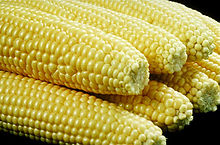This is an old revision of this page, as edited by 67.171.208.103 (talk) at 03:43, 26 November 2008 (→Trivia). The present address (URL) is a permanent link to this revision, which may differ significantly from the current revision.
Revision as of 03:43, 26 November 2008 by 67.171.208.103 (talk) (→Trivia)(diff) ← Previous revision | Latest revision (diff) | Newer revision → (diff)| This article does not cite any sources. Please help improve this article by adding citations to reliable sources. Unsourced material may be challenged and removed. Find sources: "Corncob" – news · newspapers · books · scholar · JSTOR (December 2007) (Learn how and when to remove this message) |
| This article needs attention from an expert in Agropedia. Please add a reason or a talk parameter to this template to explain the issue with the article. WikiProject Agropedia may be able to help recruit an expert. (November 2008) |


A corncob is the central core of a maize (Zea mays ssp. mays L.) ear. Young ears, also called baby corn, can be consumed raw. But as the plant matures the cob becomes tougher until only the kernels are edible. When harvesting corn the corncob is collected as part of the ear, leaving the corn stover in the field. The corn plant's ear is also considered a "cob" or "pole" but it is not fully a "pole" until the ear is shucked, or removed from the plant material around the ear. Also see corn and sweet corn and Pole Corn
Uses
Corncobs are an important source of the furfural, an aromatic aldehyde used in a wide variety of industrial processes. Although with little nutritious value, corncobs can be used as fiber in ruminant fodder. Corncobs can be used to make smoking pipes. Corncobs can also be made into charcoal. Often times mayonnaise and chili powder are spread upon the corn to enhance the flavor. "You'll never use butter again..."
Trivia
- In the NBC television drama Heroes, the character Hiro Nakamura throws corncobs at the character Matt Parkman's face as a test in the episode The Eclipse Part I.
- The character Groundskeeper Willie in the popular FOX comedy The Simpsons tries to eat his way out of his shack, which the character Bart Simpson has filled with creamed corn.
- In the XBox Live Arcade video game Castle Crashers, the boss you fight in the level entitled 'Corn Boss' is a giant corncob.
See also
External links
This agriculture article is a stub. You can help Misplaced Pages by expanding it. |